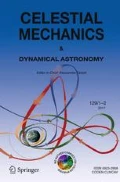Abstract
This paper is concerned with an approach for active removing of space debris by electrodynamic tether (EDT) systems in a time-optimal maneuver. In this regard, a collector–emitter system is comprised of the insulated EDT in order to generate the required electric current over a virtual circuit once the induced electric current is adopted as control force producer. To this end, a simulation program is initially developed, during which dynamic and mathematical models of the EDT as well as the geomagnetic field are encompassed, respectively. This toolset is first utilized for prediction of orbital characteristics during the deorbit process; and subsequently, using the direct transcription method, the time-optimal problem is well solved. The efficacy of the suggested technique is verified through extensive simulations once all hard constraints of the underlying problem are well satisfied. In short, while the altitude varies from 1413 to 200 km, the optimized deorbit time would reduce about 17 days.















Similar content being viewed by others
References
Argatov, I., Rautakorpi, P., Silvennoinen, R.: Apparent wind load effects on the tether of a kite power generator. J. Wind Eng. Ind. Aerodyn. 99(10), 1079–1088 (2011)
Betts, J.T.: Survey of numerical methods for trajectory optimization. J. Wind Eng. Ind. Aerodyn. 21(2), 193–207 (1998)
Bitzer, M.S.: Optimal electrodynamic tether phasing and orbit-raising maneuvers. Doctoral Dissertation, Virginia Polytechnic Institute and State University (2009)
Blumer, J.H., Donahue, B.B., Bangham, M.E., Roth, A.: Practicality of using a tether for electrodynamic reboost of the International Space Station (2001)
Bombardelli, C., Pelaez, J.: Ion beam shepherd for contactless space debris removal. J. Wind Eng. Ind. Aerodyn. 34(3), 916–920 (2011)
Buck, A.J.: An approach to optimal control of electrodynamic tethers in a stochastically varying drag environment (No. USNA-TSPR-396). Naval Academy, Annapolis, MD (2011)
Carlson, A.F.: Optimal orbit maneuvers with electrodynamic tethers. Naval Postgraduate School, Monterey, CA (2006)
Covello, F.: Application of electrical propulsion for an active debris removal system: a system engineering approach. J. Wind Eng. Ind. Aerodyn. 50(7), 918–931 (2012)
Deluca, L.T., Bernelli, F., Maggi, F., Tadini, P., Pardini, C., Anselmo, L., et al.: Active space debris removal by a hybrid propulsion module. Acta Astronaut. 91, 20–33 (2013)
Falugi, P., Kerrigan, E., Wyk E.: ICLOCS—Imperial College London Optimal Control Software, http://www.ee.ic.ac.uk/ICLOCS/user_guide.pdf (2015)
Forward, R.L., Hoyt, R.P., Uphoff, C.: Application of the terminator tether electrodynamic drag technology to the deorbit of constellation spacecraft. Acta Astronaut. 98, 3491 (1998)
Garg, D.: Advances in global pseudospectral methods for optimal control. Doctoral Dissertation, University of Florida (2011)
Gittins, G.L., Swinerd, G.G., Lewis, H.G., Williams, D.N.: A study of debris impact collision probabilities to space tethers. Acta Astronaut. 34(5), 1080–1084 (2004)
Gläßel, H., Zimmermann, F., Brückner, S., Schöttle, U.M., Rudolph, S.: Adaptive neural control of the deployment procedure for tether-assisted re-entry. Acta Astronaut. 8(1), 73–81 (2004)
Hoyt, R.P.: Design of a tether boost facility for the human Mars mission. Tethers Unlimited Inc, Seattle, WA (1999)
Iki, K., Kawamoto, S., Morino, Y.: Experiments and numerical simulations of an electrodynamic tether deployment from a spool-type reel using thrusters. Acta Astronaut. 94(1), 318–327 (2014)
Ishige, Y., Kawamoto, S., Kibe, S.: Study on electrodynamic tether system for space debris removal. Acta Astronaut. 55(11), 917–929 (2004)
Kojima, H., Sugimoto, T.: Nonlinear control of electro-dynamic tether system. In: AIAA/AAS Astrodynamics Specialist Conference and Exhibit (2006)
Kojima, H., Sugimoto, T.: Switching delayed feedback control for an electrodynamic tether system in an inclined elliptic orbit. Acta Astronaut. 66(7), 1072–1080 (2010)
Kumar, K.D., Tan, B.: Nonlinear optimal control of tethered satellite systems using tether offset in the presence of tether failure. Acta Astronaut. 66(9), 1434–1448 (2010)
Lanoix, E.L., Misra, A.K., Modi, V.J., Tyc, G.: Effect of electromagnetic forces on the orbital dynamics of tethered satellites. Acta Astronaut. 28(6), 1309–1315 (2005)
Misra, A.K.: Dynamics and control of tethered satellite systems. Acta Astronaut. 63(11), 1169–1177 (2008)
Nylin, R.: Evaluation of optimization solvers in mathematica with focus on optimal control problems. Master’s Diss., Chalmers University of Technology (2013)
Pardini, C., Hanada, T., Krisko, P.H.: Benefits and risks of using electrodynamic tethers to de-orbit spacecraft. Acta Astronaut. 64(5), 571–588 (2009)
Phipps, C.R., Baker, K.L., Libby, S.B., Liedahl, D.A., Olivier, S.S., Pleasance, L.D., et al.: Removing orbital debris with pulsed lasers. Acta Astronaut. 1464(1), 468 (2012)
Sánchez-Arriaga, G., Bombardelli, C., Chen, X.: Impact of nonideal effects on bare electrodynamic tether performance. Acta Astronaut. 31(3), 951–955 (2015)
Tintori, C., Emanuelli, M.: An active space debris removal mission: orbit, engine and gasification of residue, Doctoral Dissertation, Polytechnic of Milano, Italy (2011)
Ueno, H., Dubowsky, S., Lee, C., Zhu, C., Ohkami, Y., Matsumoto, S., et al.: Space robotic mission concepts for capturing stray objects. J. Space Technol. Sci. 18(2), 2_1–2_8 (2002)
Vannaroni, G., Dobrowolny, M., De Venuto, F.: Deorbiting with electrodynamic tethers: comparison between different tether configurations. Acta Astronaut. 1(3), 159–172 (1999)
Wen, H., Jin, D.P., Hu, H.Y.: Advances in dynamics and control of tethered satellite systems. Acta. Mech. Sin. 24(3), 229–241 (2008)
Yamaigiwa, Y., Hiragi, E., Kishimoto, T.: Dynamic behavior of electrodynamic tether deorbit system on elliptical orbit and its control by Lorentz force. Acta. Mech. Sin. 9(4), 366–373 (2005)
Zhong, R., Zhu, Z.H.: Libration dynamics and stability of electrodynamic tethers in satellite deorbit. Acta. Mech. Sin. 116(3), 279–298 (2013)
Zimmermann, F., Schöttle, U.M., Messerschmid, E.: Optimization of the tether-assisted return mission of a guided re-entry capsule. Acta. Mech. Sin. 9(8), 713–721 (2005)
Author information
Authors and Affiliations
Corresponding author
Rights and permissions
About this article
Cite this article
Amiri Atashgah, M.A., Gazerpour, H., Lavaei, A. et al. An active time-optimal control for space debris deorbiting via geomagnetic field. Celest Mech Dyn Astr 128, 343–360 (2017). https://doi.org/10.1007/s10569-017-9755-y
Received:
Revised:
Accepted:
Published:
Issue Date:
DOI: https://doi.org/10.1007/s10569-017-9755-y



